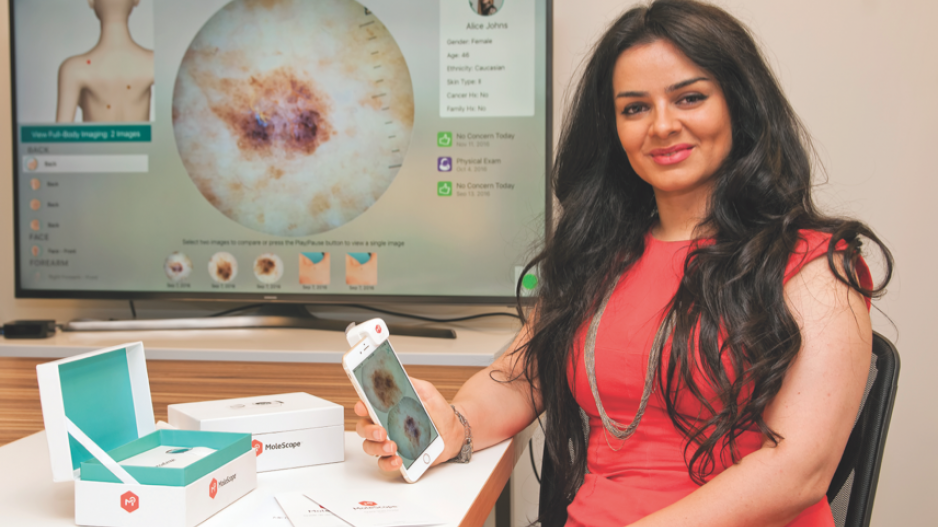Entrepreneur and computer scientist Maryam Sadeghi is confident she’s in the right place at the right time.
“I think Canada is the best place to innovate,” Sadeghi said. “We have unique programs here that you will never find, for example, in the U.S.”
Originally from Mianeh, a town in the East Azerbaijan province in northwest Iran, Sadeghi moved to Canada in 2007 to complete her PhD. She would go on to found a medical technology company, MetaOptima Technology, with her husband, fellow Simon Fraser University (SFU) alumnus Majid Razmara. She and her team developed MoleScope, a smartphone attachment that allows people to screen themselves for suspicious moles and lesions.
They couldn’t have done it all by themselves, said Sadeghi, who credited Canadian universities and government programs aimed at supporting entrepreneurs with helping her company become successful.
As MetaOptima began to take off, Sadeghi considered moving the business to San Francisco, but she decided to stay headquartered in Vancouver because of the support it provides to budding and growing businesses.
“Even our first investor was introduced to me from one of my colleagues at Simon Fraser University,” Sadeghi said. “That was the support I had at the school, and it was like I was building the business with my family at SFU and the University of British Columbia.
“Everyone here was so supportive. We also had R&D support programs like the Industrial Research Assistance Program and the Scientific Research and Experimental Development tax incentive.”
She also highlighted the province’s talent pool and access to intellectual capital as another important reason why B.C. is one of the best places to innovate. Without skilled engineers, doctors and managers to help establish MoleScope, MetaOptima may not have had the same success, she said.
Sadeghi received her undergraduate degree in computer hardware engineering from Tehran’s Iran University of Science and Technology, one of the top universities in the country. She moved to British Columbia after her graduation and completed postgraduate work at SFU while working closely with the BC Cancer Agency and the Skin Research Training Centre at the University of British Columbia (UBC).
Sadeghi loves working with computers and information technology but she is not your typical computer scientist. While her studies focused on computer visualizations, she did not see herself spending hours in front of a computer screen writing code or developing hardware. She wanted to do more than just find a job in her field; she wanted to help people.
“Life is so short, it’s not worth it to spend your time, 18 hours a day, behind a computer in a closed office,” she said. “But it is rewarding when you see others using your product.”
MoleScope was not the first time Sadeghi ventured to empower people using smartphones.
While she was completing her postgraduate work she jumped at the chance to establish herself in Vancouver’s fast-growing medical tech industry. As part of her PhD thesis, she created a smartphone app in conjunction with the Save Your Skin Foundation in Vancouver.
Sadeghi met daily with top oncologists and dermatologists to create a smartphone weather application customized for people who are sensitive to the sun, including those with skin cancer. She later donated the app to the BC Cancer Agency.
Sadeghi earned her PhD from SFU in the area of medical image analysis, while also spending as much time as she could studying dermatology at UBC. Once she received her doctorate in 2012, she and Razmara founded MetaOptima in November of that year and launched the MoleScope product in June 2015.
Sadeghi started the company because she saw an opportunity to fill a niche by applying digital technology to an under-digitized segment of the growing medical technology field. She also realized that the industry’s target market, doctors, was often inundated with new products and technologies, leaving little room in the market for MetaOptima. To have success with MetaOptima, Sadeghi said, she needed to depart from the usual way medical technology is brought to market.
According to Sadeghi, 70% of skin cancer cases are discovered by patients themselves. This created a unique opportunity to develop a customer base outside of medical professionals, she said.
While Sadeghi has had a lot of success and honours in her career – including being recently named a winner in Business in Vancouver’s Forty under 40 awards – the first real-world confirmation of MoleScope’s effectiveness was a bittersweet moment for the scientist. A close friend of Sadeghi’s was the first person to successfully identify melanoma with MoleScope.
“That was a moment where I was shocked; I didn’t know what to do,” Sadeghi said. “And she told me, ‘Maryam, this is great. This is exactly showing that Molescope works. If I found my melanoma with MoleScope, other patients can do this as well.’”
It was difficult for Sadeghi to celebrate her success under the circumstances, but remaining positive is in her nature. Even though she spends her days creating and viewing computer visualizations of cancer, she can’t help but see the positive side – even the beauty – of what she sees.
“I want to work with images; I want to work with visual things,” Sadeghi said. “For me, the visual representation of the cancer cell is like a galaxy and stars. I can see cancer cells or signs or structures in the mole, and for me it’s not scary, it’s actually beautiful that you can identify things and find information that can save people’s lives.” •




